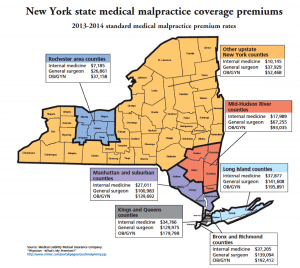We’ve talked here before about the differences between rural and urban medical work and malpractice insurance needs, and about the differences in malpractice rates from one state to another. But today we want to highlight just how dramatically location can play into what it costs to insure yourself against malpractice liability.
Take a look at the map below. No place illustrates this idea better than New York. An OB/GYN practicing in the Rochester area can expect to pay, on average, around $37k a year for malpractice insurance. In Long Island or the Bronx, it’s nearly five times that! For a general surgeon, the difference is even greater.
If you follow this link you can read more about the specifics of New York State and the rest of the data that went into compiling this map. Some of the figures are astounding. One of the most striking compares the annual malpractice costs for an allergist in Rochester ($1,905) with a neurosurgeon in Long Island ($331,295). It’s not a particularly meaningful statistic in that, of course neurosurgeons incur far more risk than allergists and always pay more for malpractice insurance; nevertheless, the scale of the discrepancy is striking. Further, the reason the numbers are so far apart isn’t just because of the difference in specialty, it’s also because of the difference in location.
The article linked goes on to discuss the role of defensive medicine and to use New York as something of a benchmark by which to compare malpractice rates in other states. As you might expect, Florida and Illinois (home of the notoriously litigious and plaintiff friendly Madison County) are notably high, even in comparison to New York’s most expensive counties, while much of the Midwest and parts of the South have lower premiums in some specialties than even the lowest rates in New York. Notably, California’s rates are substantially lower than those in New York as well.
So what’s the upshot? Well, that’s a tricky question. It’s easy to look at data like this and conclude that you just shouldn’t be a doctor in New York City or Miami. But of course there’s more to it than that. The cost of living in those cities could probably be plotted on a map like the one above with similar results. No doubt an apartment in Manhattan will cost you many times more per month in rent than a loft in Rochester. Yet people live in New York, and are happy to do so. Why? Well, for one thing while costs are higher so is pay. Across most specialties doctors in Manhattan make salaries that are about twice what their colleagues in Rochester make. So raw numbers can be deceptive. It’s a little like moving to a foreign country. A high exchange rate can be distressing until you consider that you will be working in that economy. You don’t have to pay Manhattan malpractice rates on a Rochester salary.
Further, there are the intangibles. Living in Miami, or Chicago, or the Big Apple grants you access to things—experiences, opportunities, possibilities—that might not be available in other places. We all know that a city like New York is rife with cultural and entertainment options, but as a physician it is likewise a place where there are going to be some interesting career options, where educational possibilities abound, and where there is room to experience a great deal of occupational diversity.
On the other hand, there is no getting around it, it is more expensive to practice medicine in some places than others, and New York and Miami don’t have a corner on great career opportunities. You can practice medicine in San Diego, or St. Louis, or Austin and experience some great cultural and career possibilities while spending far less on malpractice insurance.
Likewise, not everyone needs access to an ever-changing array of career possibilities. Many doctors would prefer to settle into a stable position and see it through, growing and developing over a lifetime of practicing medicine, of course, but not hopping from one position to another, or always looking for something new to do. People are different, and have different priorities.
At the end of the day though, with all the caveats and considerations taken into account, location does matter. As much as we would all like to choose where we live purely on preference, things like cost of living do make a difference; and for physicians so do malpractice rates. Whether you end up in Rochester or NYC, Dallas or Chicago, it’s important to consider what your malpractice rates are going to look like, and how that compares with typical salaries in the area. A good broker can help you find excellent coverage at competitive rates, but even the best broker isn’t going to be able to get you Rochester rates on Long Island.
This post was written by Justin Donathan.
Justin at Google+




